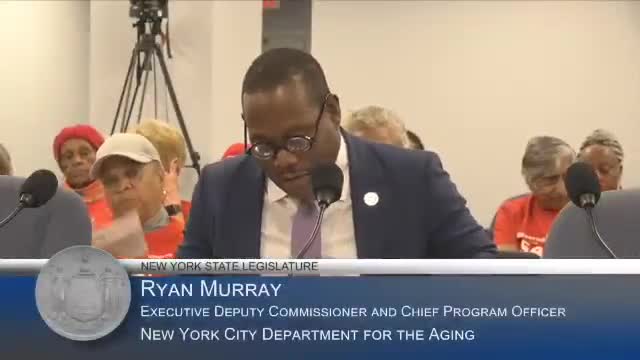NYC Aging highlights funding challenges for in-home care services amid growing older population
October 17, 2024 | Aging, Standing Committees, House, Legislative, New York
This article was created by AI summarizing key points discussed. AI makes mistakes, so for full details and context, please refer to the video of the full meeting. Please report any errors so we can fix them. Report an error »

New York City's aging services are at a critical juncture, as the demand for in-home care for older adults surges. During the Assembly Public Hearing on Expanded In-Home Services for the Elderly Program (EISEP) on October 17, 2024, officials highlighted the urgent need for enhanced funding and support to meet the growing population of seniors who wish to age in place.
With approximately 1.8 million older adults residing in the city, the call for robust in-home services has never been more pressing. The NYC Aging Commissioner emphasized that the current funding model is inadequate, with state contributions stagnating at around 18-20% of the home care budget since 2016. This has placed an increasing financial burden on the city, which is now responsible for a larger share of the costs associated with the In-Home Services for the Elderly Program (ISIP).
The Commissioner pointed out that by 2030, the older adult population in New York City is expected to exceed 1.88 million, further straining resources. The need for home care attendants is escalating, yet funding disparities mean that many providers prioritize Medicaid clients over those relying on ISIP, leading to potential gaps in care for those who do not qualify for Medicaid.
A poignant example shared during the hearing was that of a 71-year-old Brooklyn resident who, despite her chronic health conditions, does not qualify for Medicaid and requires assistance with daily activities. This situation underscores the critical role of ISIP in supporting older adults who wish to remain in their homes.
The hearing also addressed the financial implications of community care versus institutional care, with estimates showing that community care costs about $61,000 per older adult annually, compared to over $177,000 for institutional care. This stark contrast highlights the potential savings for the state if adequate funding for in-home services is prioritized.
As the city grapples with these challenges, the call for a more equitable funding formula is clear. The Commissioner concluded with a plea for collaboration to ensure that New York City's aging population receives the support they need to thrive at home, emphasizing that investing in community care is not only a moral imperative but also a financially sound strategy for the future.
With approximately 1.8 million older adults residing in the city, the call for robust in-home services has never been more pressing. The NYC Aging Commissioner emphasized that the current funding model is inadequate, with state contributions stagnating at around 18-20% of the home care budget since 2016. This has placed an increasing financial burden on the city, which is now responsible for a larger share of the costs associated with the In-Home Services for the Elderly Program (ISIP).
The Commissioner pointed out that by 2030, the older adult population in New York City is expected to exceed 1.88 million, further straining resources. The need for home care attendants is escalating, yet funding disparities mean that many providers prioritize Medicaid clients over those relying on ISIP, leading to potential gaps in care for those who do not qualify for Medicaid.
A poignant example shared during the hearing was that of a 71-year-old Brooklyn resident who, despite her chronic health conditions, does not qualify for Medicaid and requires assistance with daily activities. This situation underscores the critical role of ISIP in supporting older adults who wish to remain in their homes.
The hearing also addressed the financial implications of community care versus institutional care, with estimates showing that community care costs about $61,000 per older adult annually, compared to over $177,000 for institutional care. This stark contrast highlights the potential savings for the state if adequate funding for in-home services is prioritized.
As the city grapples with these challenges, the call for a more equitable funding formula is clear. The Commissioner concluded with a plea for collaboration to ensure that New York City's aging population receives the support they need to thrive at home, emphasizing that investing in community care is not only a moral imperative but also a financially sound strategy for the future.
View full meeting
This article is based on a recent meeting—watch the full video and explore the complete transcript for deeper insights into the discussion.
View full meeting
